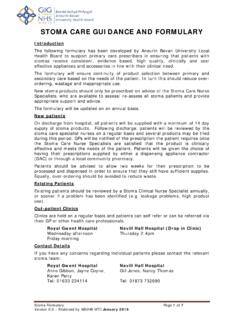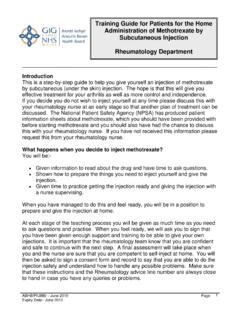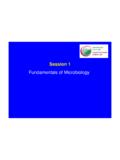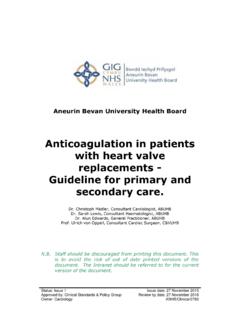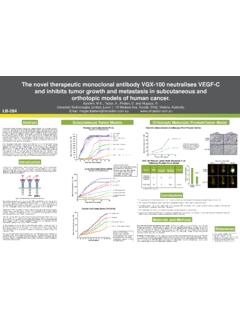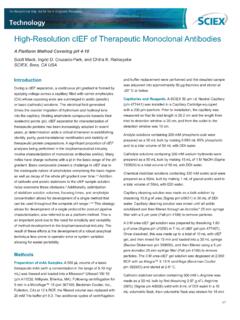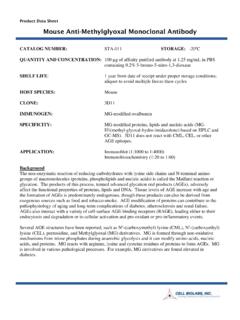Transcription of The Stability of Monoclonal Antibodies (MABs) - …
1 + The Stability of Monoclonal Antibodies (mAbs) Mark Oldcorne North Wales Pharmaceutical Quality Assurance Betsi Cadwaladr University Health Board Phil Weir Quality Control North West + What are Abs 1 Antibodies are proteins produced by the B lymphocytes of the immune system in response to foreign proteins, called antigens. Structurally Antibodies are proteins consisting of four polypeptide chains. These four chains form a quaternary structure somewhat resembling a Y shape. + What are mAbs 2 Monoclonal Antibodies are Antibodies which have been artificially produced against a specific antigen.
2 They are extremely specific and bind to their target antigens. Monoclonal Antibodies (mAb or moAb) are monospecific Antibodies that are the same because they are made by identical immune cells that are all clones of a unique parent cell Sources of MABs mouse and human (chimeric) + Source substems: naming Human parts are shown in red, non-human parts are blue Mouse Chimeric Humanized Chimeric/humanized Human + Mode of Action Bind to specific target antigens May - inhibit antigens biological actions May - cause death of target cells Specificity of action Used to treat many diseases + Protein Structure 1 Primary Structure the sequence of a chain of amino acid Secondary Structure linking of sequences of amino acids by hydrogen bonding (formation of regular sub-structures such as pleated sheets or alpha helices)
3 Tertiary Structure occurs when there are certain attractions between pleated sheets and alpha helices (3-d structures) Quaternary Structures protein consisting of more than one amino acid chain (complex of protein molecules) + Protein Structure 2 + Methods of mAbs Degradation Chemical degradation of amino acids Fragmentation Denaturation of tertiary structure disruption of bonds essential for native configuration Aggregation to form dimers, tetramers or larger aggregates Adherence - extremely interactive with surfaces of all types. They can potentially bind or interact with containers, filers and tubing + Potential MAB instability Physical denaturation of tertiary structure disruption of bonds essential for native configuration self-association into dimers, tetramers or larger aggregates Chemical disulphide formation and exchange deamidation isomerisation oxidation crosslinking non-reducible formation of acidic and basic species - fragmentation + Factors affecting degradation Temperature Freezing pH extremes Surfactants Pressure Shaking \ Shearing Light (uv)
4 Metals Oxygen Presence of water Absence of water Denaturants Excipients Interfaces factors influence development, production, preparation, storage & handling + Source Guidance 1 INTERNATIONAL CONFERENCE ON HARMONISATION OF TECHNICAL REQUIREMENTS FOR REGISTRATION OF PHARMACEUTICALS FOR HUMAN USE ICH HARMONISED TRIPARTITE GUIDELINE Stability TESTING OF NEW DRUG SUBSTANCES AND PRODUCTS Q1A(R2) Current Step 4 version dated 6 February 2003 Generally applies to small medicine molecules + Source Guidance 2 QUALITY OF BIOTECHNOLOGICAL PRODUCTS: Stability TESTING OF BIOTECHNOLOGICAL/BIOLOGICAL PRODUCTS Q5C Current Step 4 version dated 30 November 1995 RQC Yellow Cover document - Stability + Scope of Q5C Q5c - characterised proteins and polypeptides their derivatives and products of which they are components and which are isolated from tissues, body fluids, cell cultures, or produced using rDNA technology cytokines (interferons, interleukins, colony-stimulating factors, tumour necrosis factors)
5 Erythropoietins plasminogen activators blood plasma factors growth hormones and growth factors insulins Monoclonal Antibodies vaccines consisting of well-characterised proteins or polypeptides Q5C - does not cover antibiotics, allergenic extracts, heparins, vitamins, whole blood, or cellular blood components. + Stability Approach Primary data to support a requested storage period long-term, real-time, real-condition Stability studies Preferable to not use accelerated \stressed Stability testing + Biologicals specifically mAbs active components are typically proteins and/or polypeptides Therefore maintenance of molecular conformation and, hence of biological activity, is dependent on non-covalent as well as covalent forces.
6 Particularly sensitive to environmental factors such as temperature changes, oxidation, light, ionic content, and shear. In order to ensure maintenance of biological activity and to avoid degradation, stringent conditions for their storage are usually necessary. + Potential MAB instability Chemical instability Physical Instability Loss of Biological activity + Evaluation of mAbs Stability assays for biological activity, where applicable, should be part of the pivotal Stability studies Potency appropriate physicochemical, biochemical and immunochemical methods for the analysis of - the molecular entity - the quantitative detection of degradation products Purity and quality + Stability -indicating Profile no single Stability -indicating assay or parameter - profiles the Stability characteristics of a biotechnological/biological product the Stability -indicating profile should provide assurance that changes in the Identity Potency Purity Other characteristics of the product will be detected the determination of which tests should be included will be product-specific + Potency 1 Potency.
7 Potency is the specific ability or capacity of a product to achieve its intended effect When the intended use of a product is linked to a definable and measurable biological activity, testing for potency should be part of the Stability studies In general, potencies of biotechnological/biological products tested by different laboratories - expressed in relation to an appropriate reference material (linked to national or international reference standard) Biological characteristics immunoreactivity and crossreactivity the determination of relevant functional characteristics binding studies to determine affinity How do we measure?
8 What is acceptable? + Potency 2 Receptor Studies Cell Line Studies Clinical Effect + Purity and Molecular Characterisation 1 Purity is a relative term the absolute purity of biologicals is extremely difficult to determine the purity of a biotechnological/biological product should be typically assessed by more than one method purity value derived is method-dependent tests for purity should focus on methods for determination of degradation products The degree of purity, as well as individual and total amounts of degradation products of the biological product limits of acceptable degradation should be derived from the analytical profiles of batches of the drug substance and drug product used in the preclinical and clinical studies.
9 + Purity and Molecular Characterisation 2 The use of relevant physicochemical, biochemical and immunochemical analytical methodologies should permit a comprehensive characterisation drug substance and/or drug product ( , molecular size, charge, hydrophobicity) accurate detection of degradation changes during storage + Purity and Molecular Characterisation 3 Method Information Visual Appearance of solution particulate material pH Optimised conditions for Stability Particle Counting / Microflow Imaging Presence of aggregates\presence of silicone oil droplets Size Exclusion Chromatography (SEC HPLC) Size distribution, degradation products (high molecular weight), dimers and aggregates, quantification (mg/ml) Identification, higher structure (2o and 3o structure), adsorption, physical changes Capillary electrophoresis (SDS-PAGE)
10 Size distribution, degradation products (small molecular weight). Information on identification and chemical changes Peptide Mapping AA sequence chemical changes Total Protein Assay (BCA) Loss of protein - adsorption High-resolution chromatography ( , RP, gel filtration, ion exchange, affinity) Identification and quantification of biological and degradation products + Other characteristics The following product characteristics should be monitored and reported for the drug product in its final container: Visual appearance of the product colour and opacity for solutions/suspensions colour.
